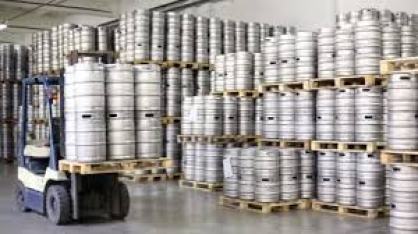In the 1960s, Willowbrook Distributing warehouse, used by Coors of Dallas, was considered an upscale building. The facility was large, the trucks were able to load indoors, the warehouse temperature was controlled and there were rail sidings. The warehouse also provided multiple offices, a break room, locker rooms, a hospitality room, a check-in area, and of course, executive offices.
Until this time, I had little knowledge of the differences between beer warehouses. While at Lone Star, I had two distributors whose warehouses were actually old barns. Both warehouses were similar with a couple of pallets of beer and a forklift. There was an Oklahoma distributor who operated out of a former railroad station. The trucks would pull up alongside the passenger docks and the beer was hand loaded onto the vehicles. Obviously a great deal of manual labor was involved.
In Chicago, a number of the current beer warehouses still have roots dating back decades with little to no updates. This is difficult to understand considering the onslaught of new brands, flavors, and SKUs. In today’s high tech market, warehouses are computer driven with little that remotely resembles the beer facilities of 50 years ago. Interestingly, the one exception to this rule is the beer pallets, which remain basically unchanged.
A four year old West Texas AB house is a great illustration of a state-of-the-art beer warehouse. The storage area is computer operated, the temperature is controlled with high tech equipment, and the facility boasted all the bells and whistles one could imagine. And, of course, the warehouse was built with future growth in mind. Interestingly, when taking a tour of the facility we discovered that the sales department was dark and empty. It was also immediately apparent that the modern-designed desks were not in use…there were no computers, no phones, no papers, no p-o-s, no glasses…empty.
The only people in the building, outside of the warehouse, were the reception and financial staff in the front of the facility. The most heavily used portion of the building; however, was the new gym and workout facility installed by the distributor. The distributor indicated that the gym was most heavily used by the staff during the early mornings, late afternoons and on the weekends.
The question in today’s beer industry is what will the modern beer facility look like and how will it function? It is obvious that a sales department, now automated, is out selling. There is no need to go into the warehouse, except for meetings. Will such an arrangement be sufficient going forward? Should the empty desks be removed and a game room added? Maybe provide a ping pong table, a couple of X Boxes and big flat screen TVs with overstuffed chairs and music. Many of the companies who want to attract younger, educated Millennials are modifying their offices to meet this generation’s expectations.
It is safe to say that parts of the beer industry are slow to change, warehousing, however, is not. Companies have to keep up with industry trends and this should apply to their current and future employees.
The future belongs to those who prepare for it today.
Editor’s Note. Attention all former Schlitz employees and Schlitz Distributors: The family of James Haire is searching for a booklet created by Jim during his tenure at the Schlitz training institute years ago. The booklet is approximately 20 pages in length with a plastic cover complete with Jim’s photo. If you have a copy, or know where one can be located, please let us know. The family would like be most appreciative.

Leave a Reply